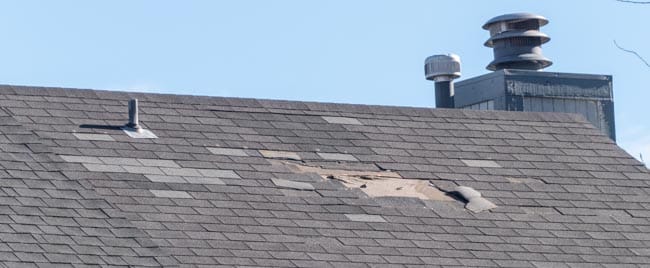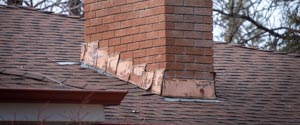It just rained and you’re wondering how your roof is doing. Is it leaking? Signs your roof is leaking are sometimes obvious, such as a stain on your ceiling, or water or rust around your stove pipe. Other signs of a roof leak you might not notice when you’re sitting at your dining room table. Keep an eye out for these 7 signs your roof is leaking and act immediately to keep your roof lasting as long as possible.
Quick Answer: Common signs your roof is leaking include a stain on your ceiling, mold in your attic, water or rust around your stovepipe, missing roofing material, and ceiling dripping.

1. Stain or Wet Spot on Your Ceiling
One of the obvious signs your roof is leaking is a stain on your ceiling. More than likely, that water is coming from a damaged roof or missing roofing materials. If you see a wet spot or stain on your ceiling, get your roof and attic inspected right away. The longer you wait, the more damage there will be and the more it will cost to repair.
If the stained ceiling is below another floor, you might have an interior water leak, such as from a washing machine or dishwasher or bathtub.
2. Moisture or Mold in the Attic
If you have moisture or mold in the attic, it could be from a few things.
a. Your Roof is Leaking From Either Damaged or Missing Roofing Material
This could be from an old roof. For example, if enough granules are missing from asphalt shingles, water can soak through to the underlayment and deck then into the attic. Similarly, if the roofing material is missing or damaged, rain can easily get onto the roofing deck and into your attic.

b. Your Attic Isn’t Being Properly Ventilated
An improperly ventilated attic isn’t necessarily a sign of a leaking roof, but it’s worth mentioning here. More often we come across improperly ventilated attics in older homes, such as before the 1980s. If you have moisture or mold in your attic, and you don’t have roof damage, and your appliances and vents from fans are venting directly to the outside, you might just need your current attic ventilation inspected and possibly add more vents, or upgrade your existing ones.
c. Appliances or Fans are Being Vented to Your Attic and There Isn’t Adequate Ventilation to the Outside.
If appliances or fans, such as fans in the bathroom, are being vented into the attic, and if the attic isn’t being vented properly, this can also cause mold to grow in the attic. It’s important to vent appliances and fans directly to the outside, and make sure your attic is being properly vented.
Whether your roofing material is missing or damaged, or you have an improperly vented attic, have a roofing professional inspect your roof and attic immediately if you suspect moisture or mold in your attic.
3. Wet Roof Deck
Another sign of roof leak is a wet roof deck. The roof deck is the 4′ x 8′ sheets of board your roof gets secured to. It is visible from your attic. If the deck is wet, this is another sign your roof is leaking because rain or snow is coming through, or around, your roofing material and underlayment. Which means your roofing material is damaged or missing. Most folks don’t crawl around in their attic, therefore, they never notice if their roof deck is wet. However, if you do notice your deck is wet, schedule a roof and attic inspection immediately before further damage is caused.
4. Water or Rust Around a Stove Pipe
If you see water coming down your stove pipe, such as on a fireplace, or you notice pipe is rusting, this means the flashing around the pipe on the roof isn’t properly sealed and letting rain water in. If you catch this in time, it can be a quick and inexpensive repair by simply adding more sealant around the pipe flashing, or replacing a few asphalt shingles. As with anything, the longer you wait, the more damage there can be and the more costly the repairs. Again, if you see water or rust on your stove pipe, call a roofing professional for an inspection and repair.
5. Defective Flashing
Another sign of a leaking roof is defective flashing. Flashing is a transitional material. That is, it goes between two other materials. For example, flashing goes between asphalt shingles and your chimney. A sealant gets applied to the joints between these different materials. Defective metal flashing is quite common, given the high winds we get along the Colorado Front Range. High winds can pull material loose, as can tree branches fall or rubbing on your roof. When metal flashing is pulled-up or damaged, rain can get underneath it and cause damage. Similarly, if joints are broken around the metal flashing, rain can get through and cause damage. Either way, if you spot damaged or defective metal flashing, call your roofing professional for an inspection, and possibly repairs.

6. Missing Roofing Material
Missing roofing material, such as asphalt shingles or tiles, are a sure sign you have a roof leak. Your roofing material is the first line of defense against rain, snow, hail, fire, wind, sun, debris, etc. Without it, your home wouldn’t last very long. Without your roof, moisture would quickly rot your roof deck, cause an electrical fire, and more.
7. Dripping Water
If you see water dripping from your ceiling, you probably have a leaking roof. This may be due to a damaged roof deck, or an unpatched hole in your roof deck, in addition to insufficiently sealed roofing material, or missing or damaged roofing material. If your roofing material isn’t sealed, water can seep through it. If there’s a hole in your roof deck, water can then get into your attic and eventually onto your ceiling.
Do I Need to Replace My Entire Roof If It’s Leaking?
It depends. For example, a small hole in your roof can easily be repaired without replacing your entire roof. If most of the granules are missing from your asphalt shingle roof, then your whole roof should be replaced. A few loose shingles can probably be nailed back down. If there’s extensive hail damage to your roof, again, you probably need your entire roof replaced. If you know your roof is leaking, contact us for a free inspection so we can determine the extent of the damage. Remember, minor damages left alone can lead to big damages, and more costly repairs, later.
The Bottom Line
The sooner you spot the above signs, the sooner you can stop damage from spreading, and the lower your roof repair bill will be. If the leak isn’t coming from your roof but it’s an interior leak, you might be interested in repairing it yourself. It’s a good idea to inspect, or have your roof inspected, every year. However, you don’t want to walk on your roof frequently as walking on your roof slowly breaks it down. If you have an asphalt shingle roof, those granules come off as you walk on them. The above signs can be spotted from within your attic or room, or from a ladder beside your roof.
